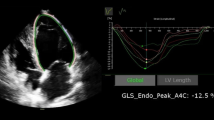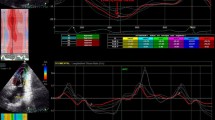Abstract
The aim of this study was to investigate subclinical LV changes in patients with maintenance hemodialysis (MHD) using three-dimensional speckle-tracking echocardiography (3DSTE) and to explore its prognostic value. A total of 88 individuals were consecutively enrolled, including 66 subjects with MHD and 22 age- and sex-matched controls. Conventional and Real-time three-dimensional echocardiography was performed and analyzed. Left ventricular volume, strain and time parameters were calculated and compared. The MHD cohort was then followed to record cardiovascular events (CVE). Univariate and multivariate logistic regression analysis was used to identify independent predictors of CVE. Compared with the controls, MHD patients had significantly lower global longitudinal and radial strain (GLS and GRS), and LVEF (GLS: −17.0 ± 2.3 vs −18.8 ± 2.3 %; GRS: 37.0 ± 3.5 vs 39.4 ± 3.4 %; LVEF: 57.3 ± 4.2 vs 59.5 ± 3.5 %, p < 0.05 for all), as well as enlarged LV volume (EDV: 51.3 ± 14.2 vs 40.4 ± 7.3 ml/m2; ESV: 22.0 ± 6.9 vs 16.3 ± 3.2 ml/m2; SV: 29.2 ± 8.0 vs 24.0 ± 4.7 ml/m2, p < 0.01 for all) and LV mass index (LVMi) (107.7 ± 28.6 vs 83.7 ± 20.6 g/m2). Time to minimum end-systolic volume and to peak longitudinal strain (T-msv and T-ls) were delayed in the MHD group (T-msv: 38.1 ± 5.2 vs 41.4 ± 6.4 %; T-ls: 38.1 ± 4.6 vs 42.1 ± 6.8 %, p < 0.05). Systolic dyssynchrony index (SDI) of the MHD group was significant larger than that of the controls (6.4 ± 1.5 vs 4.9 ± 1.8 %, p < 0.01). CVE occurred in 23 patients within a follow-up of 2 years. GLS and LVMi remained significant predictors of CVE [OR = 3.94, 95 % CI (1.33–11.66) for GLS and OR = 1.04, 95 % CI (1.01–1.07) for LVMi, p = 0.013 and 0.009, respectively]. Subclinical LV deformation and dysfunction exist in MHD patients with preserved LVEF. GLS and LVMi are two important predictors of CVE in MHD patients. Strain assessment in MHD patients may contribute to better vascular risk stratification.



Similar content being viewed by others
References
House AA (2012) Cardio-renal syndrome type 4: epidemiology, pathophysiology and treatment. Semin Nephrol 32(1):40–48
Sarnak MJ, Levey AS, Schoolwerth AC et al (2003) Kidney disease as a risk factor for development of cardiovascular disease: a statement from the American Heart Association Councils on kidney in cardiovascular disease, high blood pressure research, clinical cardiology, and epidemiology and prevention. Circulation 108:2154–2169
Pecoits-Filho R, Barberato SH (2010) Echocardiography in chronic kidney disease: diagnostic and prognostic implications. Nephron Clin Pract 114(4):242–247
Kleijn SA, Aly MF, Terwee CB, van Rossum AC, Kamp O (2012) Reliability of left ventricular volumes and function measurements using three-dimensional speckle tracking echocardiography. Eur Heart J Cardiovasc Imaging 13(2):159–168
Kleijn SA, Brouwer WP, Aly MF et al (2012) Comparison between three-dimensional speckle-tracking echocardiography and cardiac magnetic resonance imaging for quantification of left ventricular volumes and function. Eur Heart J Cardiovasc Imaging 13(10):834–839
Gayat E, Ahmad H, Weinert L, Lang RM, Mor-Avi V (2011) Reproducibility and inter-vendor variability of left ventricular deformation measurements by three-dimensional speckle-tracking echocardiography. J Am Soc Echocardiogr 24(8):878–885
K/DOQI Workgroup (2002) National Kidney Foundation K/DOQI clinical practice guidelines for chronic kidney disease: evaluation, classification, and stratification. Am J Kidney Dis 39:S1–S266
Lang et al (2015) Recommendations for cardiac chamber quantification by echocardiography in adults: an update from the American Society of Echocardiography and the European Association of Cardiovascular Imaging. J Am Soc Echocardiogr 28(1):1–39
Kang Y, Sun MM, Cui J et al (2012) Three-dimensional speckle tracking echocardiography for the assessment of left ventricular function and mechanical dyssynchrony. Acta Cardiol 67(4):423–430
Herzog CA, Asinger RW, Berger AK et al (2011) Cardiovascular disease in chronic kidney disease. A clinical update from kidney disease: improving global outcomes (KDIGO). Kidney Int 80(6):572–586
K/DOQI Workgroup (2005) K/DOQI clinical practice guidelines for cardiovascular disease in dialysis patients. Am J Kidney Dis 45(4):S1–153
Foley R, Parfrey P, Kent G, Harnett J, Murray D, Barre P (2000) Serial change in echocardiographic parameters and cardiac failure in end-stage renal disease. J Am Soc Nephrol 11(5):912–916
Yamada S, Ishii H, Takahashi H et al (2010) Prognostic value of reduced left ventricular ejection fraction at start of hemodialysis therapy on cardiovascular and all-cause mortality in end-stage renal disease patients. Clin J Am Soc Nephrol 5(10):1793–1798
Wang A, Lam C, Chan I, Wang M, Lui S, Sanderson J (2010) Sudden cardiac death in end-stage renal disease patients: a 5-year prospective analysis. Hypertension 56(2):210–216
Lang et al (2012) EAE/ASE recommendations for image acquisition and display using three-dimensional echocardiography. J Am Soc Echocardiogr 25(1):3–46
Bansal N, Keane M, Delafontaine P et al (2013) A longitudinal study of left ventricular function and structure from CKD to ESRD: the CRIC Study. Clin J Am Soc Nephrol 8(3):1–8
Amundsen BH, Helle-Valle T, Edvardsen T et al (2006) Noninvasive myocardial strain measurement by speckle tracking echocardiography: validation against sonomicrometry and tagged magnetic resonance imaging. J Am Coll Cardiol 47(4):789–793
Helle-Valle T, Crosby J, Edvardsen T et al (2005) New noninvasive method for assessment of left ventricular rotation: speckle tracking echocardiography. Circulation 112(20):3149–3156
Altekin RE, Kucuk M, Yanikoglu A et al (2012) Evaluation of the left ventricular regional function using two-dimensional speckle tracking echocardiography in patients with end-stage renal disease with preserved left ventricular ejection fraction. Acta Cardiol 67(6):681–691
Yan P, Li H, Hao C et al (2011) 2D-speckle tracking echocardiography contributes to early identification of impaired left ventricular myocardial function in patients with chronic kidney disease. Nephron Clin Pract 118(3):232–240
Jacob LD, Salgo IS, Goonewardena S et al (2006) Rapid online quantification of left ventricular volume from real-time three-dimensional echocardiographic data. Eur Heart J 27(4):460–468
Chen R, Wu X, Shen LJ et al (2014) Left ventricular myocardial function in hemodialysis and nondialysis uremia patients: a three-dimensional speckle-tracking echocardiography study. PLoS One. 9(6):e100265
Kovács A, Tapolyai M, Celeng C et al (2014) Impact of hemodialysis, left ventricular mass and FGF-23 on myocardial mechanics in end-stage renal disease: a three-dimensional speckle tracking study. Int J Cardiovasc Imaging 30(7):1331–1337
Liu YW, Su CT, Sung JM et al (2013) Association of left ventricular longitudinal strain with mortality among stable hemodialysis patients with preserved left ventricular ejection fraction. Clin J Am Soc Nephrol 8(9):1564–1574
Krishnasamy R, Hawley CM, Stanton T et al (2015) Left ventricular global longitudinal strain is associated with cardiovascular risk factors and arterial stiffness in chronic kidney disease. BMC Nephrol 18(16):106–112
Chiu DY, Green D, Abidin N, Sinha S, Kalra PA (2014) Echocardiography in hemodialysis patients: uses and challenges. Am J Kidney Dis 64(5):804–816
Liu YW, Su CT, Wang SP et al (2011) Application of speckle-tracking echocardiography in detecting coronary artery disease in patients with maintenance hemodialysis. Blood Purif 32(1):38–42
Tsai WC, Liu YW, Huang YY, Lin CC, Lee CH, Tsai LM (2010) Diagnostic value of segmental longitudinal strain by automated function imaging in coronary artery disease without left ventricular dysfunction. J Am Soc Echocardiogr 23(11):1183–1189
Kang SJ, Lim HS, Choi BJ et al (2008) Longitudinal strain and torsion assessed by two-dimensional speckle tracking correlate with the serum level of tissue inhibitor of matrix metalloproteinase-1, a marker of myocardial fibrosis, in patients with hypertension. J Am Soc Echocardiogr 21(8):907–911
Cheng A, Helm RH, Abraham TP (2009) Pathophysiological mechanisms underlying ventricular dyssynchrony. Europace 11(suppl 5):v10–v14
Spragg DD, Kass DA (2006) Pathobiology of left ventricular dyssynchrony and resynchronization. Prog Cardiovasc Dis 49(1):26–41
Hayashi SY, Nowak J, Lindholm B et al (2013) Left ventricular mechanical dyssynchrony in patients with different stages of chronic kidney disease and the effects of hemodialysis. Hemodial Int 17(3):346–358
AlJaroudi W, Aggarwal H, Venkataraman R, Heo J, Iskandrian AE, Hage FG (2010) Impact of left ventricular dyssynchrony by phase analysis on cardiovascular outcomes in patients with endstage renal disease. J Nucl Cardiol 17(6):1058–1064
Liodakis E, Sharef OA, Dawson D, Nihoyannopoulos P (2009) The use of real-time three-dimensional echocardiography for assessing mechanical synchronicity. Heart 95(22):1865–1871
Soliman OI, van Dalen BM, Nemes A et al (2009) Quantification of left ventricular systolic dyssynchrony by real-time three-dimensional echocardiography. J Am Soc Echocardiogr 22(3):232–239
Acknowledgments
This study was supported by grants from National Natural Science Foundation of China (81371576).
Author information
Authors and Affiliations
Corresponding author
Ethics declarations
Conflict of interest
No conflict of interest to disclose.
Rights and permissions
About this article
Cite this article
Sun, M., Kang, Y., Cheng, L. et al. Global longitudinal strain is an independent predictor of cardiovascular events in patients with maintenance hemodialysis: a prospective study using three-dimensional speckle tracking echocardiography. Int J Cardiovasc Imaging 32, 757–766 (2016). https://doi.org/10.1007/s10554-016-0836-x
Received:
Accepted:
Published:
Issue Date:
DOI: https://doi.org/10.1007/s10554-016-0836-x




